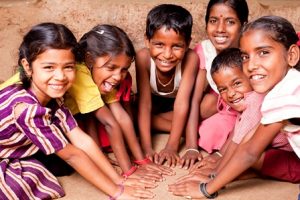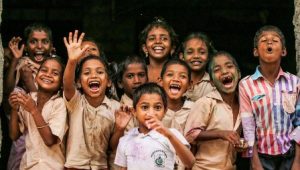Human Trafficking and Bonded Labour: Govt Should Direct Cash Transfer of Rs 6000
At least, 55.2 crore people will get benefited and protected from bonded labour, human trafficking, forced labour, starvation, child labour and child marriage and will also reduce the social unrest and crimes.
A few adolescent children in Namakkal District, Tamil Nadu, went to the elderly destitute woman whom they knew was hungry to give her their savings. Is India’s fight against hunger to be  reliant on the small savings of boys like this, whose own families are also struggling for their next meal?
reliant on the small savings of boys like this, whose own families are also struggling for their next meal?
Crores of migrant workers, unorganised workers, street vendors, self-employed and workers in private sectors have lost their livelihood and are struggling with terrible hardships due to the continuous lockdown in the country since March. The pandemic has created an unprecedented economic scenario in the history of India. The Centre for Monitoring Indian Economy (CMIE) estimated that 122 million Indians lost their jobs during the lockdown in April. More than three-fourth of them are wage labourers and small traders. Tamil Nadu is among the worst-hit states. CMIE also reveals that five million salaried people lost their jobs in July. It is corroborated by the findings of the survey conducted by the Azim Premji University, which showed that 67 per cent of workers lost jobs during lockdown; the worst affected was the self-employed (84 per cent) in urban areas, compared with 76 per cent salaried workers and 81 per cent casual workers.
The joint report by the International Labour Organisation (ILO) and the Asian Development Bank (ADB) released in August 2020 estimated that 4.1 million youth in India lost jobs due to the pandemic; construction and farm sector account for the majority of job losses. All these data clearly indicate that there are loss of jobs and livelihood income. The loss of income has a direct impact on vulnerable sections of the society and makes them struggle for their day-to-day needs such as food items, medical care, payment of rent and electricity for houses and other incidental expenses. It pushes them into extreme poverty.
According to the United Nations report published last year, it was estimated that 28 percent of the total population (364 million) in India are poor people. The current economic situation adds many more millions to this segment. The poor people are trying to cope with the existing situation by reducing their essentials including food intake and borrowing loan either from the money lenders or employers.
Shanthi, Melmathinipatti village, says, “I am the breadwinner of the family. As my income reduced, I couldn’t feed my children three times. I try my best to feed at least twice a day”. We don’t know when the situation will resume to normal. The government had given cash assistance of Rs 1000 only once which is not at all sufficient for even 10 days”. G. Malleeswari, Dindigul District, Tamil Nadu, said that she stopped purchasing milk for the last four months to cut down the expenses. The ground realities of marginalised and disadvantaged communities are worse than our imagination.
A survey with more than 480 hamlets in 11 states conducted by Community Led Local Entitlement Claim Tracker (COLLECT) found that the loss of income caused an increase in the uptake of loans at high rates of interest.
The continuous income loss will lead to indebtedness which would be resulted in the increase of incidents of human trafficking, bonded labour, and forced labour, child labour, child marriage and other social problems.
Also Read : Preventing Child Marriages: PCMA and the Road to be Taken
The women and children will be affected to a greater extent. It might also increase the suicide among the affected communities. The database of reported non-virus deaths in India, created by the Jindal Global School of Law showed that suicide was the leading cause of all non-virus deaths reported between 26 March and 11 June 2020. Out of 298, 109 suicides (37 per cent) were due to financial distress/shortage of food and starvation.
Other countries realised the sufferings of the people and announcement stimulus packages for supporting the affected people. For example, in Canada, monthly USD 1400, in Hong Kong, 1280 dollars, in Japan 931 dollars, South Korea 820 dollars and in Singapore 422 dollars, in America, 1200 dollars one time, have been directly transferred for those who have lost jobs and employment. Like these countries, the Government of India also should take measures to support the vulnerable families who lost jobs and income. S Irudaya Rajan, an expert on migrant issues, opined that the unplanned nationwide lockdown has forced millions of migrants to return home empty-handed and the government should make a direct cash transfer of Rs 25,000 to each of them to salvage the situation. Several other political parties, trade unions and experts also demand the government for direct cash transfer though there are difference of opinion in the amount per family.
 However, the discussions with unorganised workers and migrant labourers reveal that they need at least Rs 6000 (Rs 200 per day for a family) per month for four months, so that they will be protected against hunger and indebtedness. It should be directly transferred through their bank accounts. For identification of vulnerable families, the government can use its existing database—Below Poverty Line (BPL) families, ration card, aadhaar card, registration information with the unorganised workers’ welfare board and information obtained from Panchayati Raj Institutions (PRIs).
However, the discussions with unorganised workers and migrant labourers reveal that they need at least Rs 6000 (Rs 200 per day for a family) per month for four months, so that they will be protected against hunger and indebtedness. It should be directly transferred through their bank accounts. For identification of vulnerable families, the government can use its existing database—Below Poverty Line (BPL) families, ration card, aadhaar card, registration information with the unorganised workers’ welfare board and information obtained from Panchayati Raj Institutions (PRIs).
In order to raise the voice of the marginalised communities, the Tamil Nadu Alliance in collaboration with other NGOs and survivors networks such as Tiruppur Peoples’ Forum, Multi-Stakeholder Initiative – Tamil Nadu, Campaign Against Camp Coolie System, Shout for Freedom, Campaign Against Child Labour, Friends Alliance, COLLECT and other networks, initiated a nation-wide signature campaign demanding Direct Cash Transfer of Rs.6000 for at least four months to the families affected by lockdown. More than 200 NGOs from 23 states participated actively in the campaign and reached out to nearly 1.5 million people and got their support for this campaign. The signed formats will be handed over to the Prime Minister for further action.
This possible demand could be considered by the Central Government if the questions on how much it would cost? and where does the money come from? are answered. The average family size in India is 4.6 as per National Family Health survey (NFHS-4; 2015–16). The total population is around 138 crores as per information in Worldometer. Approximately, there are 30 crore households in India. The UN report of last year estimated that 28 percent of total population in India is poor. There will be an increase in this number during the pandemic.
It is estimated that 40 percent of the total households (12 crores) need direct cash transfer support. The total expenditure per month is Rs 72,000 crores; for four months Rs288,000 crore.
Also Read : Bonded and freed: Now reclaiming their lives
Hence, the total requirement would be approximately Rs 288,000, which is less than 2 per cent of GDP.
As per budget announcement of the government, the total estimated expenditure for 2020-21 is Rs 30,42,230 lakh crores. Government has committed for Rs 61,500 crore for MGNREGA scheme; around Rs 75,000 crore for PM-Kisan; Rs 471,378 is allocated for Ministry of Defence from which Rs 94,275 crores (20 per cent) could be leveraged. Government plans to bring MGNREGS to small cities and spend Rs 35,000 crore to create jobs for urban poor. The total of all these schemes pooled together generates Rs 265,775 crores. Government allocated 13 per cent for central sector schemes and 10 per cent for other expenditures. The deficit could be taken from these budget line items. Moreover, stopping the subsidy on corporate tax would add substantial contribution. Therefore, the demand from the marginalised communities is realistic and doable.
Moreover, it is reiterated that the loss of employment and indebtedness will lead to bonded labour and human trafficking. If they are not supported with Direct Cash Transfer, there will be an increase in the bonded labour. For example, even 5 percent of the vulnerable families will be in the trap of bonded labour, it will be 600,000 households with 27,00,000 population. If they are rescued, each person should be given with a minimum of Rs100,000 for supporting their rehabilitation as per Central Sector Scheme on Bonded Labour. If they are trafficked, they will be paid compensation under Victim Compensation Scheme. In addition, the Central and State Governments have to use human, time and other resources for rescuing and rehabilitating the bonded labour. The cost of rescue and rehabilitation are multi-folded than investing in prevention.
The government has the duty to protect its citizens from exploitation, bonded labour and human trafficking and ensure food security for all. Hence, it should seriously consider the demand for direct cash transfer of Rs 6000 for four months to vulnerable families as an investment. At least, 55.2 crore people will get benefited and protected from bonded labour, human trafficking, forced labour, starvation, child labour and child marriage and will also reduce the social unrest and crimes.
